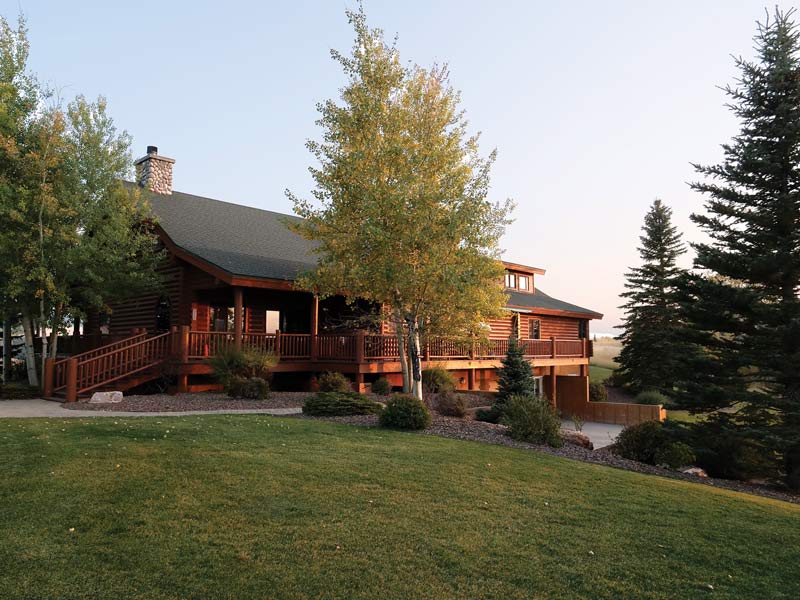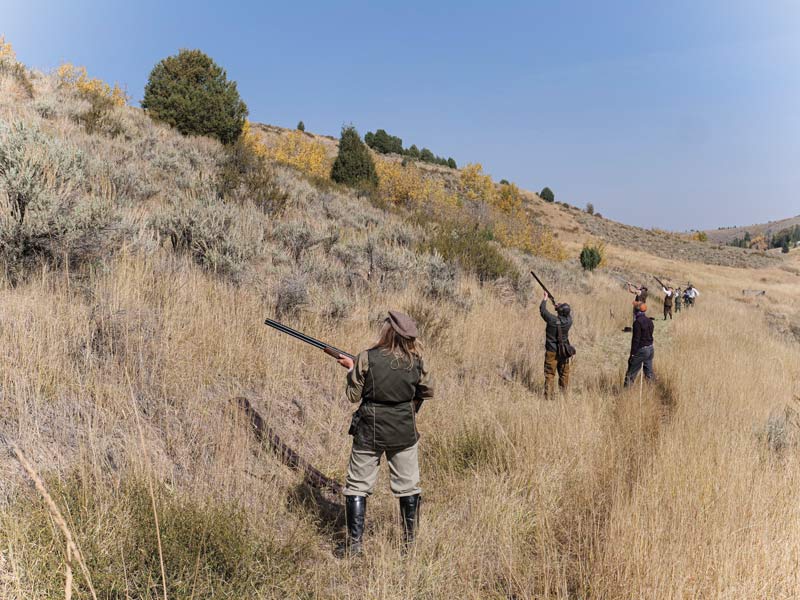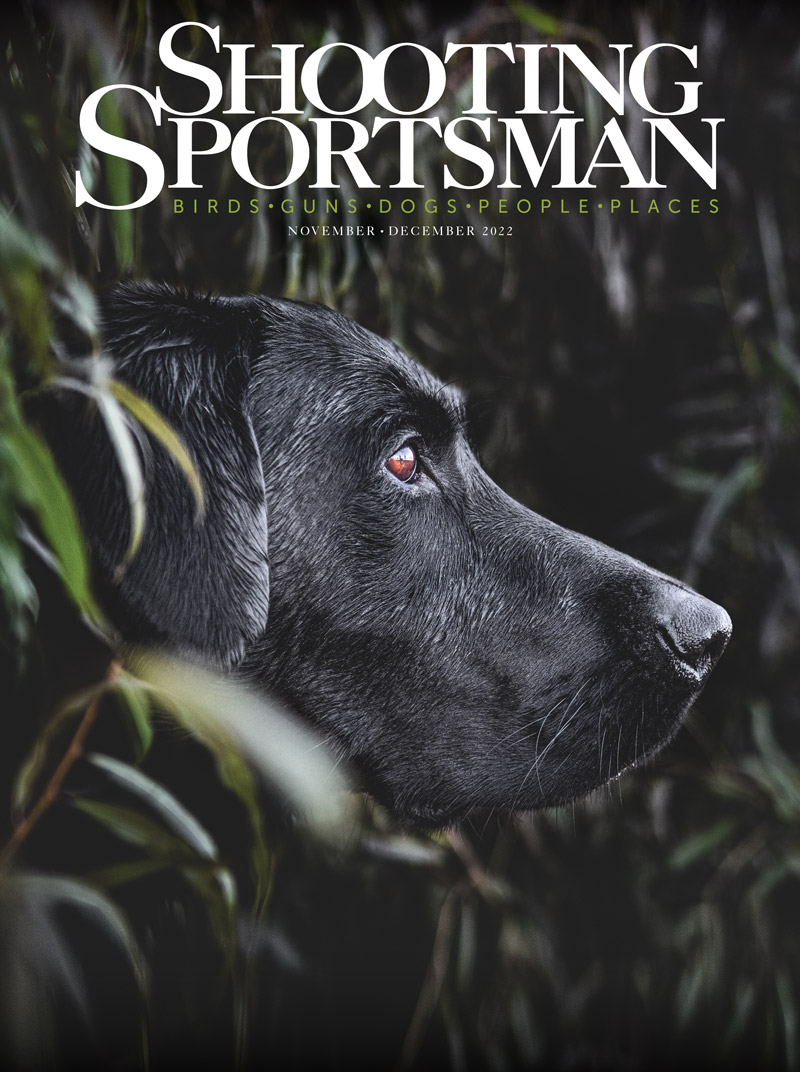Photographs by the Author
Impossible!” I pronounced after my tenth miss of an impossibly towering clay seeming to float between Doug firs scratching the clouds. “Show me how.”

Hank McKinnel stepped to the station and called for the target. There’s no way he’ll scratch it. And he didn’t. Until his third shot. Then the crazy, deceptive, curving, falling-while-it-appears-to-be-climbing little disc of clay broke. The echoes of the shot had long faded before we heard the shower of falling pieces on the forest floor.
“I’ve had some chances to work on that shot,” Hank humbly confessed. That made sense, because Hank owns the clays course we were shooting. It’s part of his 2,200-acre Lazy Triple Creek Ranch, an hour’s drive west of Jackson Hole. My wife, Betsy, and I visited one recent fall despite Covid lockdowns and masking mandates. We didn’t get Covid, but we shot plenty of clays and birds.
“Covey’s on one,” Hank said. “About fifty yards up.” He, his wife, Joanna, Betsy and I were following my setter down one of the many food plots Hank and his ranch manager, Steve Sorensen, maintain for their released pheasants and chukars.
“Oh, yeah,” I said. “I see her tail. Looks solid. Come on up.” As Hank and I rattled milo leaves, Joanna and her Beretta 20-gauge guarded the left flank where short wheat stubble suggested no bird would run. Based on her earlier work on the sporting clays course, I knew no bird would fly past her either. Betsy followed the group with a camera.
The bird that had riveted Covey’s attention was pinned and out of ground-game options, so it took to the air, clattering from the milo stalks. “Rooster!” Tail flexing in the wing wash and russet sides shining, the pheasant angled Joanna’s way. Bad choice. Her shot stopped it and simultaneously spooked a chukar that broke to my right. I swept twin barrels through it, slapped the trigger and spooked a second ringneck. Bing, bang, boom—three birds down. Hank could have all the towering clays he wanted. Joanna and I would take our birds with feathers. Fortunately, Lazy Triple Creek is a spectacular place to get both.
Spread across the west flank of Idaho’s Big Hole mountains near Driggs and bordering national forest on the east, Lazy Triple Creek Ranch is a shotgunner’s dream date. Hills, canyons, flats, streams. Conifers, aspens, grass, grain. Pheasants, chukars and every clay target game you can imagine. There’s even limited elk hunting, pistol ranges, rifle targets as distant as a mile, and challenging, small-water cutthroat and brook trout fishing on the ranch’s streams.

It wasn’t always like this, of course. Native Americans, mountain men, ranchers and 20th Century sportsmen were hunting the area’s mule deer, elk, black bears, cougars, ruffed grouse and blue grouse long before Hank acquired the property. But they were limited by what nature provided. Today’s hunters are not. Hank provides all the clays one cares to shoot. Ranch manager Steve Sorensen supplements the wild-bird production with liberated chukars and pheasants. While Hank likes booking families and groups so they can have the whole place to themselves, he also arranges special events like “English Style Driven Shoots with Western Sensibilities.” We indulged one of those—with dozens of birds flying off high ridges over nattily dressed shooters on pegs in the canyon bottoms.
“Behind you!” Betsy warned as I scanned the sky to my left. I spun right to see two roosters and a hen zipping toward the tips of the towering firs on the shady side of the canyon between the next shooter and me. I snapped up the side-by-side 20 and swung, but the bird fell in an explosion of feathers a split second before I pulled the trigger. I switched to the second rooster and fired a split second after it, too, took the pattern from the other gun. Timing is everything. Fortunately, I turned back left in time to engage a big, low rooster bombing in. There was no time to think, and as a result I nailed it.
Shooters in plus fours and tweeds as well as Western dress were popping high-flying birds all along the roadway. Dog handlers sat behind them in the shade of the firs, their yellow, red and black Labradors waiting patiently. It was controlled pandemonium—birds coming in flurries, shooters fumbling for shells, birds thumping the ground until Sorensen blew his horn for peg rotation. Then the dogs went to work gleaning the field.
Other folks deserved a chance to enjoy a facility like this.
Despite all the rotations, I never did find the butt that radically improved my hit percentage. These birds were flying routes at altitudes I’d rarely seen during 54 years of rough shooting from Dakota to Oregon. English style indeed. I’m clearly an American boy.
During our three-day visit, Betsy and I discovered that Lazy Triple Creek Ranch is a target-rich environment, but that almost took a back seat to the impressive landscape, lodge, cuisine and hospitality. Despite our combined 70 years in Idaho, neither of us was expecting the dramatic canyons mixed with silver sage, yellowing grasses and yellow aspens shimmering against the high mountain flanks cloistered in dark firs. This stunning tableau had the feel of a South Dakota CRP field one afternoon, a northern Wisconsin grouse woods that evening and a Montana mountain wilderness the next morning. At the edge of one field Hank and Joanna showed us the drag marks left by a cougar that had ambushed a cow elk there two nights earlier. If any scent remained, my setter showed no fear of it. She scoured the field—nothing but pheasants and a stray ruffed grouse in her nose.

“While we have ruffed grouse and duskies [formerly blue grouse], we don’t often hunt them,” Hank explained when we stopped his Ranger to watch a pert ruffed grouse strut across the trail.
Covid was raging during our visit, so the 9,000-square-foot, nine-bedroom log lodge where guests typically stay was closed; but we were more than comfortable in the exclusive three-bedroom Creek Cabin, the only other housing on the ranch. Originally there were supposed to be more structures, but the financial crash of 2008 altered plans. Back then an investment group from Jackson Hole bought the old cattle ranch and wheat farm with plans to create a community of wingshooting enthusiasts. Edward Watson, Shooting Estate Manager and Executive Director of the West London Shooting School, was brought in to create a shooting facility that could compete with anything in Europe. He succeeded, but the economic downturn of ’08 ended the development plan.
Subsequently, five wealthy families from Jackson Hole took over the completed project and for the next 12 years ran it as a private shooting club for friends and family. Hank joined as a partner in 2012 and added pistol and rifle ranges. By 2019 other partners were losing interest, so Hank bought them out.
“I realized that a large property such as this would deteriorate over time if used by only my family and friends,” Hank told me. “You have to use and maintain the traps, the ranges, and the roads and trails. Besides, other folks deserved a chance to enjoy a facility like this. I think it’s important to encourage family participation in the shooting sports and hunting. So Joanna and I decided we’d open the facilities for the enjoyment of others.”

But, as Hank pointed out, Lazy Triple Creek Ranch is no typical commercial operation. “We value the private, exclusive nature of this place over maximizing commercial success,” he said. “Letting small groups and families book the entire ranch and facilities is an odd way to run a business, but it works for us and our guests who relax knowing they have the lodge and ranch to themselves during a long shooting weekend.”
Our visit was perhaps more exclusive than most, thanks to Covid. Dinners were an intimate picnic—just the four of us on the veranda with the sunset glowing and the evening chill calling for a cozy jacket, a glass of Malbec and ah! It was a delightful end to the day.
“Some of our guests tell us they come to Lazy Triple Creek Ranch as much for the meals and wines as for the hunting and shooting,” Hank said. “We welcome those in for just a day with coffee, pastries, juices, fruit, yogurt, an introduction to the day’s activities and a safety briefing on the deck, weather permitting. We break for elevenses in the field and a lunch of soup and sandwiches, chili or burgers prepared by our full-time private chefs.
“Those staying for several days of shooting wake to a full ranch breakfast of waffles, bacon, eggs and healthier fare, if desired. A more substantial elevenses is served on white tableclothes in the field, with a fire in the cooler months. Lunch is similar to that enjoyed by those here for the day, but dinner is a five-star presentation of appetizers, steak, salmon, even ribs served by chefs we bring in from Jackson Hole’s finest restaurants. No one leaves Lazy Triple Creek Ranch hungry.”
Such exclusivity, if not dining, must have been typical here when native tribes hunted grizzlies, elk, deer and bison, but that changed dramatically in July 1832. That was when the largest Mountain Man Rendezvous of all time took place, and it happened just 12 miles east of the ranch. Some 400 trappers converged to debauch along the banks of the Teton River. William Sublette, Jim Bridger and Thomas “Broken Hand” Fitzpatrick were there. So was Jean Baptiste Charbonneau, famous papoose of Sacagawea on the Lewis & Clark Expedition. There were 108 lodges of Nez Perce, 80 of Flatheads and a support herd of some 3,000 horses. Can’t you just picture it? Teepee poles poking through a golden morning miasma of fog and campfire smoke, the Teton Range towering snow-capped to the east, the 9,000-foot Snake River Mountains to the south curving into the 9,000-foot Big Horns on the west.

Young John Colter was the first US citizen to see this basin, passing through it during his 1808 winter trading expedition that put him on the frozen shore of Yellowstone Lake on Christmas. Hot pools. Geysers. Bubbling mud pots. Glass mountains. Colter’s Hell.
In the 1860s the last of the mountain men, Richard “Beaver Dick” Leigh, was roaming the valleys and streams here, likely taking fur from the very willow-lined creeks for which Lazy Triple Creek Ranch is named. In 1872 he guided the Hayden geological survey, and then the first ascent of Grand Teton soon after. Leigh Lake in Grand Teton National Park is named after him; Jenny Lake after his wife.
And now you, too, have the chance to hunt and shoot in the shadows of history on Lazy Triple Creek Ranch. Warm up on the trap and skeet ranges. Try 5 Stand among the aspens or Crazy Quail over the sage. Or get humbled by the Edward Watson–designed 14-station clays course. You’ll never see a trap as you wend your way through woods and meadows, across burbling brooks, and into deep canyons over which clays magically soar and drift and curl in dizzying directions sufficient to frustrate the finest shotgunner. Then when you’re tuned and ready, there are the birds.
Ron Spomer lives off-grid on Dancing Springs Ranch, in Idaho, where he and his wife, Betsy, produce solar electricity, chickens, garden produce and enough firewood to keep them from freezing. He has published thousands of articles and photos in dozens of gun and hunting magazines. He and Betsy currently produce YouTube videos, podcasts and blogs at ronspomeroutdoors.com.
Buy This Issue!
Read our Newsletter
Stay connected to the best of wingshooting & fine guns with additional free content, special offers and promotions.






Ron, isn’t this the place Blixt & Co. put on the map? I seem to remember the driven shooting they offered was at this ranch once upon a time. Interesting. Thanks for reviewing.